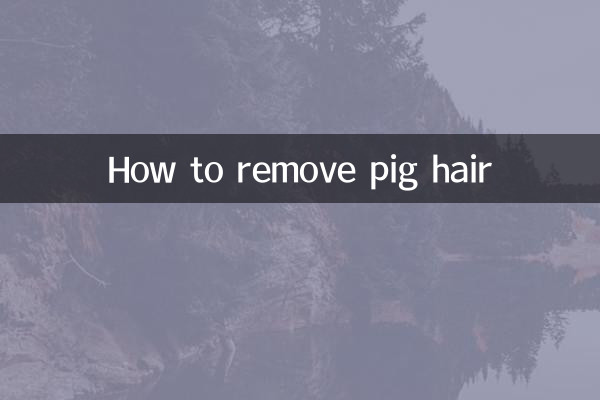How to remove pig hair
Removing pig hair is an essential step when cooking pork. Pig hair not only affects the taste, but may also carry bacteria, so thorough removal of pig hair is the key to ensuring food safety and deliciousness. This article will introduce you in detail several common methods for removing pig hair, and attach relevant data and tool recommendations to help you easily solve this problem.
1. Common ways to remove pig hair

Here are several common methods for removing pig hair and their advantages and disadvantages:
| method | Operation steps | advantage | shortcoming |
|---|---|---|---|
| Fire burning method | Directly burn the pig's skin surface with a musket or open flame | Quick and thorough | Professional tools are required, which may produce burnt smell |
| Shaving method | Shave pig hair with a knife or a stripper | Simple and easy to do | Possible fine hair roots |
| Boiling water scalding method | Scarton the pig's skin with boiling water and shave it | Soften hair follicles for easy removal | Takes a long time |
| Tweezers removal method | Use tweezers to remove pig hair | Totally clean | Time-consuming and labor-intensive |
2. Tool recommendations
Choosing the right tool can greatly improve hair removal efficiency. The following are several commonly used hair removal tools and their characteristics:
| Tool name | Applicable scenarios | Price range |
|---|---|---|
| Musket | Professional kitchen or large batch processing | RMB 100-300 |
| Shaving knife | Daily use of home | RMB 20-50 |
| Electric hair removal device | Efficiently remove fine hair | RMB 150-500 |
| tweezers | Local fine processing | RMB 5-20 |
3. Detailed explanation of the operation steps
Here are the detailed steps to remove pig hair using fire burning:
1.Preparation: Place the pork on a fire-proof countertop to make sure there are no flammable items around.
2.Caused pig skin: Use a musket or open flame to burn the surface of the pig skin evenly until the pig hair is completely carbonized.
3.Scrape off residue: Use a knife or a hair scraper to gently scrape off the carbonized pig hair and skin.
4.Clean: Rinse the pork with clean water to make sure that all residues are removed.
4. Things to note
1.Safety first: Be sure to pay attention to fire prevention when using a musket to avoid burns or fires.
2.Clean thoroughly: After removing pig hair, be sure to rinse the pork thoroughly with clean water to avoid residual carbide affecting the taste.
3.Choose the right method: Choose the most suitable hair removal method according to the location and quantity of pork.
5. Other tips
1.Soak in boiling water: Soak the pork in boiling water for 3-5 minutes to soften the hair follicles and facilitate scraping.
2.Salt rub: Sprinkle salt and rub it on the pig's skin to help remove small hair.
3.Clean vinegar water: Clean the pork with diluted vinegar water to remove odor and clean it further.
6. Summary
Although removing pig hair seems simple, it requires patience and skills. Choosing the right method and tool can help you achieve twice the result with half the effort. Whether it’s home cooking or a professional kitchen, mastering these tips will make your pork dishes more perfect. Hope this article can provide you with practical help!

check the details

check the details